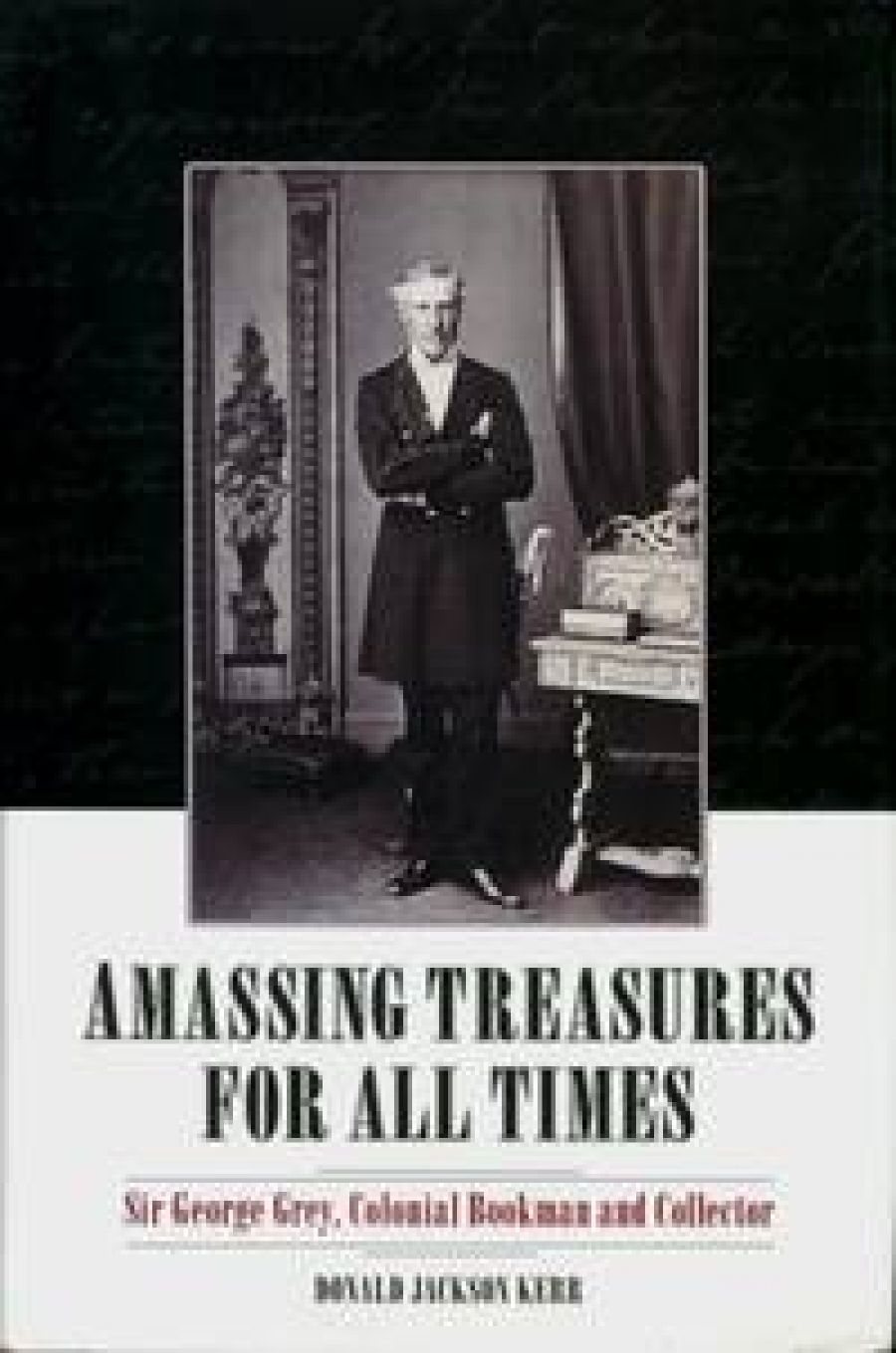
- Free Article: No
- Contents Category: Biography
- Review Article: Yes
- Article Title: Bio-bibliography
- Online Only: No
- Custom Highlight Text:
Bibliomania is a disease that has afflicted men, and occasionally women, in many walks of life. Some of the most famous cases have been extremely wealthy bachelors, like Richard Heber in England and David Scott Mitchell in Australia, whose only interest in life was collecting books and manuscripts. At the other end of the spectrum have been men who were leaders in business, the professions or politics, yet who still had the time, energy and money to amass huge collections. Sir John Ferguson in Australia, John Pierpont Morgan and Henry Huntington in America, William Gladstone in England and Sir George Grey in New Zealand fall into the latter category.
- Book 1 Title: Amassing Treasures For All Times
- Book 1 Subtitle: Sir George Grey, colonial bookman and collector
- Book 1 Biblio: University of Otago Press, $49.95 hb, 351 pp
Grey’s public life began in 1841, when he was appointed the third governor of South Australia, and ended in 1891, as a delegate at the Australasian Federal Convention in Sydney. In between, he served two terms as governor of New Zealand (before and after the granting of self-government), was governor of the Cape Colony, held a seat in the New Zealand Parliament for twenty years, and was prime minister for two years. His public life has been examined in six substantial biographies, the most recent by Edmund Bohan in 1998. However, Grey’s book collecting has received perfunctory attention. Donald Jackson Kerr has now filled the gap with an exemplary study of an eminent Victorian collector.
Grey began collecting in the 1830s and continued until his death in 1898. He sold some of his books at auction in 1853, but to a great extent his library has been kept intact, although in two locations. In 1861–64 he presented a large collection of books and manuscripts to the South African Public Library. In 1886 he donated an even larger collection to the Auckland Free Public Library, and he continued to transfer books in his last years. Dr Kerr was in charge of the Grey Collection at Auckland, and his study is based on a long and intimate knowledge of the books, including their inscriptions and annotations, in both collections. He was also able to draw on Grey’s extensive correspondence with dealers and his marked-up copies of their catalogues. He lists hundreds of individual titles, referring to their rarity, previous owners, dates of acquisition and prices. The level of detail is astonishing. An entire chapter is devoted to examining the works that Grey selected from two catalogues issued by the London dealers Thomas and William Boone in 1862–63.
Grey was catholic in his collecting. He followed the great aristocratic collectors in seeking medieval manuscripts, Caxtons and other incunabula, classical texts, chivalric romances, first folios of Shakespeare and early travel writings. The manuscripts comprised not only missals, psalters and books of hours, but works of Aristotle, Cicero, Juvenal, Boethius and Boccaccio. Remote from the centres of the book trade, he depended largely on the catalogues of English and German dealers. He was often too late, but it was a buyer’s market and without ever paying huge prices he assembled the finest collection of medieval manuscripts ever seen in the southern hemisphere. His collecting did not stop in the sixteenth century. Exploiting his position as governor and drawing on a network of printers, dealers, missionaries and collectors, Grey acquired books, pamphlets and ephemera published in New Zealand, Australia, South Africa and the Pacific Islands. He prided himself on his knowledge of indigenous languages, and in 1846 he began assembling an extraordinary collection of Maori manuscripts and publications. He later achieved similar success with publications in African languages, saving languages that were in danger of disappearing. Grey was a pioneer in recording indigenous cultures, and it is significant that today the Maori manuscripts are the most heavily used component of the Auckland collection.
Kerr refers to his book as a bio-bibliography. He provides information about Grey’s family, childhood and military training, but the biography peters out in 1837, when Grey first set sail for Australia. Kerr probably assumes that readers will be familiar with Grey’s vice-regal and political careers, whereas his career as a collector has been neglected. It is a reasonable assumption, but a little more contextual information would have been useful. Over the years, the collecting varied in intensity, and Grey seems to have been most acquisitive not in retirement but when he was administering a turbulent colony. For instance, his collecting of European manuscripts and early books peaked in 1856–59, at a stressful time when he was feuding with the Colonial Office and his marriage was foundering. As a colonial administrator, Grey has been described as an enigma, at times enlightened and idealistic, but also autocratic, unscrupulous, vacillating and egotistical. In contrast, as a collector he is portrayed by Kerr as wholly admirable: scholarly, industrious, generous and democratic, with a strong public purpose underlying his collecting.
Nicholas Basbanes, in A Gentle Madness (1995) and other books, has written in a racy style about the immense wealth, rivalries and deviousness of the great book col lectors. Kerr’s sober and well-documented study has far less drama, for Grey was not especially wealthy; he seldom spent more than a few pounds on a book, and he did not view other collect-ors as rivals. Nevertheless, the book makes a major contribution to the history of private libraries, collecting and the book trade in the nineteenth century. There are no compar-able books on Mitchell, Ferguson, William Dixson and the other leading Australian collectors. English col lectors such as the Duke of Roxburghe and Sir Thomas Phillipps have attracted more attention by bibliographers, but Kerr’s comprehensive analysis of the formation of the Grey Collections sets a new benchmark.


Comments powered by CComment